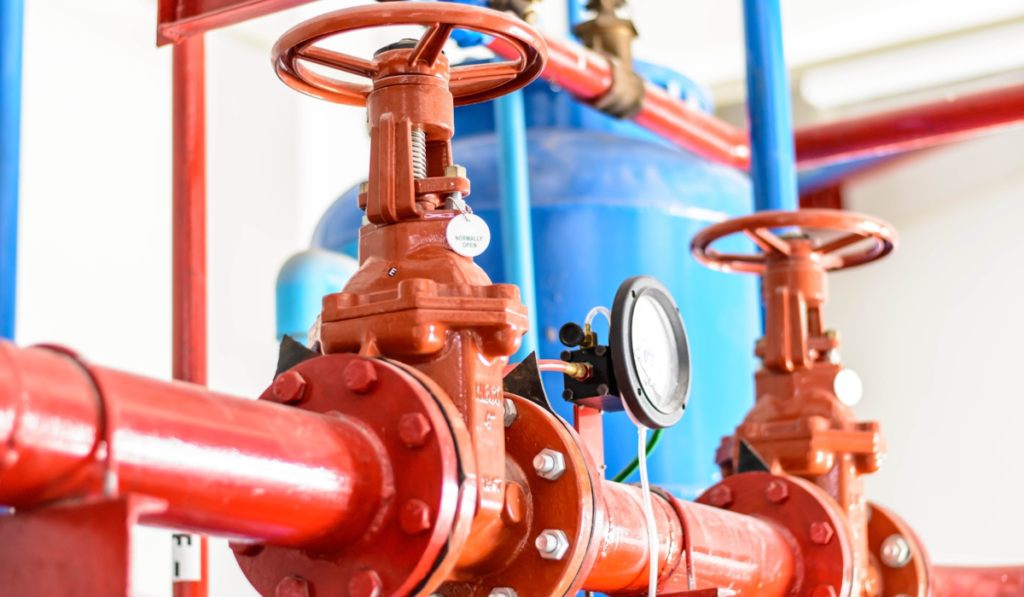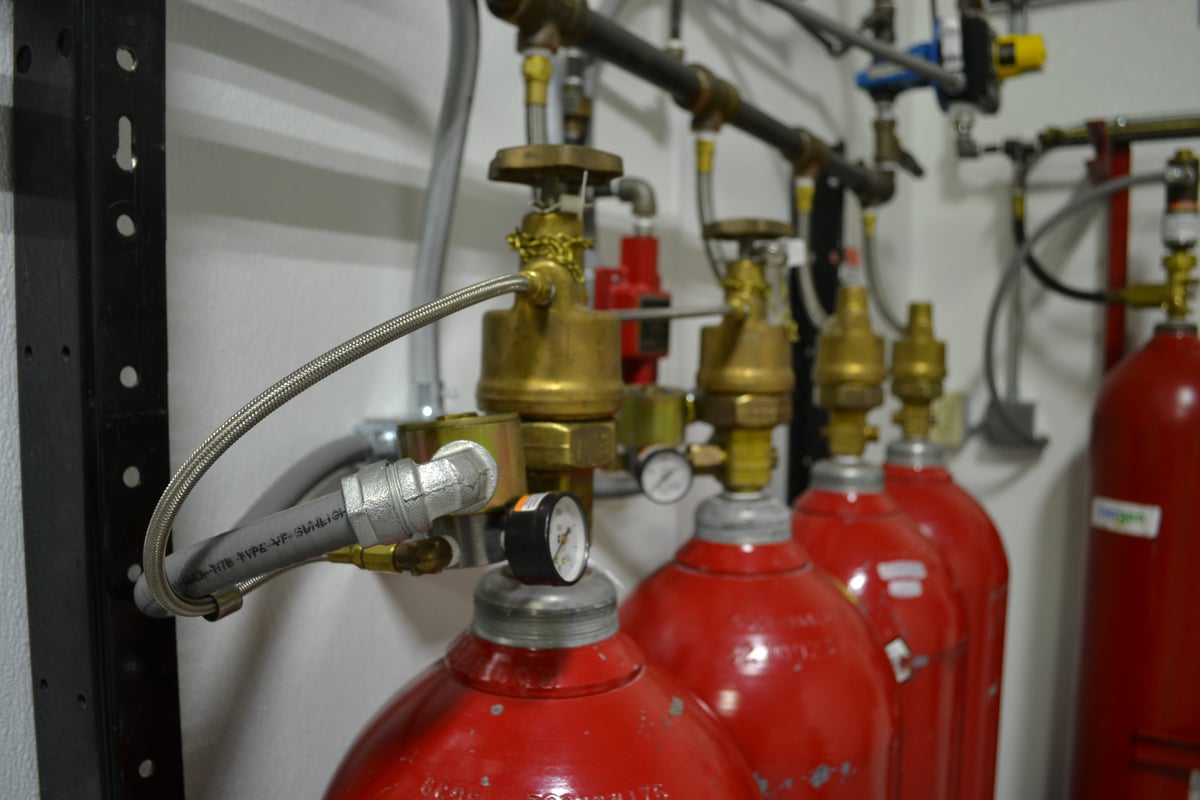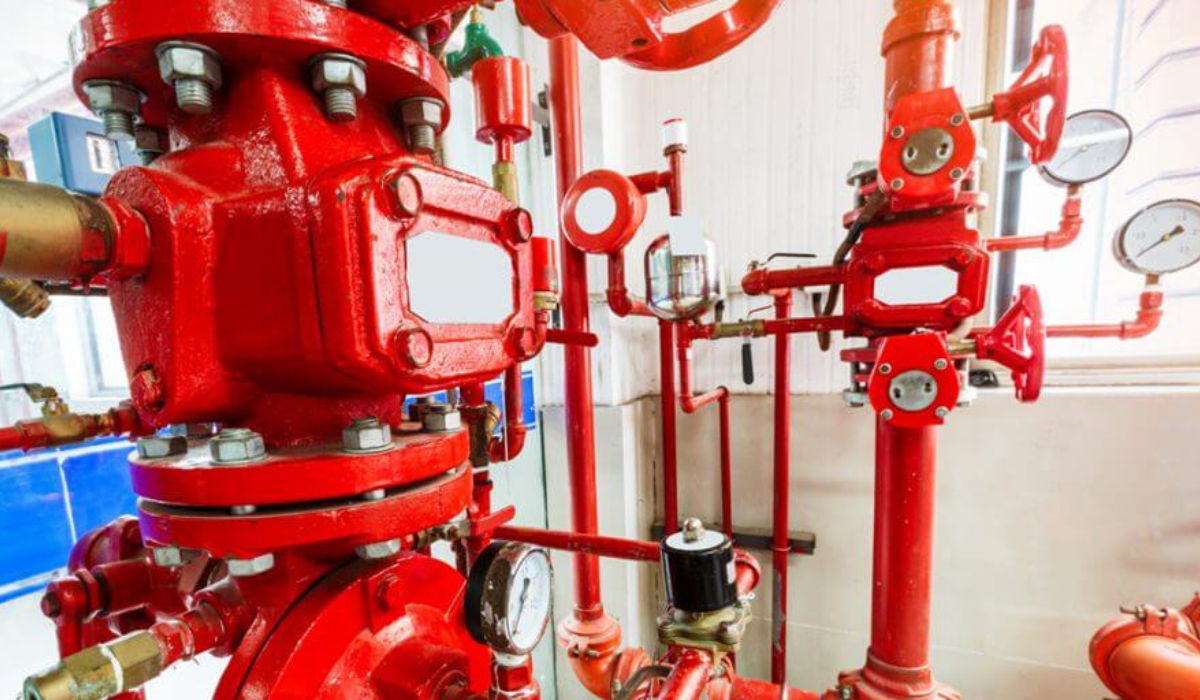A Dry Fire Suppression System is an engineered fire protection unit that uses inert gases or chemical agents to extinguish a fire without water. It activates automatically during a fire incident.
This system is essential for areas where water damage from traditional sprinkler systems could be problematic or where valuable, sensitive equipment is present. Dry systems offer an effective solution for data centers, telecommunications sites, and cultural heritage facilities. They work by displacing oxygen, removing heat, or inhibiting the chemical reactions that fuel a fire.
Protecting critical assets and electronics from collateral water damage makes dry fire suppression a preferred choice for specialized environments. The design of these systems typically allows for fast activation to minimize damage and ensure business continuity after a fire event. Safety and preservation are paramount, and dry fire suppression systems provide peace of mind with minimal impact on the protected assets and the environment.

Intro To Dry Fire Suppression
Safety in places like museums or data centers is key. Water from sprinklers can damage valuable items. Dry fire suppression systems offer protection without water. These systems use gases or chemicals to stop fires. They safeguard important stuff by not using water. Let’s explore why dry systems are a great choice for some places.
Why Dry Over Wet?
Dry systems do not use water. This means no water damage. Electronics and art stay safe. The systems work fast to put out fires. Occupants are not exposed to harmful sprinkler byproducts. Dry systems can protect in cold areas where water freezes.
Key Components
Dry fire suppression systems have several main parts. A control panel is the system’s brain. It sends signals to start the suppression process. There are detectors that sense fire or smoke. These trip the system into action. Notification devices alert people when there’s a fire. Then, gas or chemical agents stored in cylinders get released. These agents put out the fire. Finally, discharge nozzles spread the agent evenly in the room. All these parts work together to stop fires.
- Control Panel: It’s the command center for the system.
- Detectors: These sense the fire and trigger the system.
- Notification Devices: These warn people in the building.
- Agent Cylinders: They store the gas or chemicals used to suppress the fire.
- Discharge Nozzles: Spread the agent to extinguish the fire.
Types Of Dry Suppression Systems
Protecting valuable assets from fire is crucial. Dry fire suppression systems are a top choice. Unlike traditional water-based systems, these systems use agents that leave no residue. This quality is essential for areas housing sensitive electronic equipment or valuable goods. Various types of dry systems cater to different needs. Let’s explore some prominent ones.
Chemical-based Systems
Chemical-based suppression systems use compounds that stop fire chemically. They interrupt the fire triangle – heat, fuel, and oxygen. Typically, these systems release a fine powder or gas that coats the flames. This process extinguishes fires without water damage.
- Aerosol suppressants: create a fog that blocks flames.
- FM-200: a gas that draws heat from fire, putting it out quickly.
- FE-13: has a lower concentration level, ideal for occupied spaces.
Inert Gas Systems
Inert gas systems use gases that deprive fire of oxygen. They are eco-friendly and safe for humans. Here’s how they work:
| Gas Type | How It Works | Applications |
|---|---|---|
| Argonite | Combines nitrogen and argon to displace oxygen. | Archives, museums |
| Nitrogen | Floods the area with pure nitrogen. | Data centers, server rooms |
| INERGEN | Blends gases that lower oxygen to safe levels. | High-occupancy buildings |
Both chemical and inert gas systems are designed to minimize damage to property during a fire incident. They are ideal solutions where traditional sprinkler systems may harm more than help.
How Dry Suppression Protects Assets
In the fight against fires, dry fire suppression systems stand out for their efficacy. These systems do not use water. Thus, they prevent water damage to equipment during a fire emergency. Discover how these state-of-the-art systems safeguard your assets with precision and care.
Minimal Damage To Equipment
Dry fire suppression systems use gas or chemical agents to quell fires. This method ensures your equipment stays free from corrosive water damage. Here are major benefits:
- No residue left on machines or electronics
- Quick return to operation post incident
- Reduced cleanup costs and downtime
Suitable For Sensitive Environments
Environments like data centers or art galleries require special protection. Dry suppression systems are perfect for these. Key advantages include:
| Environment | Benefit |
|---|---|
| Data Centers | Keeps critical data storage safe |
| Museum & Art Galleries | Protects invaluable artifacts and artworks |
| Laboratories | Guards sensitive scientific equipment |
Choose dry fire suppression to shield valuable assets and ensure a swift revival post-disturbance.
Advantages Of Dry Systems
Protecting a building from fire hazards is critical. Dry fire suppression systems offer unique benefits that traditional wet systems can’t match.
Immediate Activation
Dry fire suppression systems respond instantly to fire. There’s no water in the pipes, so air pressure drops fast when activated. This triggers the system to release the extinguishing agent. It swiftly douses fires saving lives and property.
Environmental Impact
- No water damage: Because these systems don’t use water, they reduce the risk of water damage to property.
- Eco-friendly agents: Many dry systems use eco-friendly agents. These agents help protect the earth.
Maintenance And Durability
Dry fire suppression systems are tough. They work well in cold places where water could freeze. Regular check-ups and cleanings make them last longer. This makes these systems a reliable choice for any building.
Design Considerations
When it comes to safeguarding your assets, a Dry Fire Suppression System is a top pick. Design considerations are vital to ensure the system operates flawlessly during an emergency. Let’s delve into the specifics that will guide a robust and efficient design.
Space Requirements
Calculating the space where the Dry Fire Suppression System will be installed is crucial. The system must fit within the designated area, providing optimal coverage.
- Measure the area’s dimensions
- Factor in room for system components
- Check for unobstructed system deployment
Adequate space helps ensure quick and effective activation of the system when needed.
System Customization
Customization is essential to meet specific protection needs of a facility. Here’s what to look for when customizing:
| Customization Aspect | Details |
|---|---|
| Agent Type | Select based on the types of fires expected |
| Nozzle Placement | Strategic locations for maximal coverage |
| System Size | Scale as per area size and risk level |
System customization allows for tailored fire protection that aligns with unique site requirements.
Compliance With Regulations
To ensure your system is both legal and effective, adhere to regulations. Key compliance factors include:
- Checking local and national fire codes
- Adhering to industry standards
- Acquiring necessary certifications
A system that meets compliance standards ensures reliability and integrity in fire emergencies.

Credit: blog.koorsen.com
Installation Process
Installing a Dry Fire Suppression System ensures your facility is ready to tackle fires without water.
The installation process requires careful planning, precise designing, and seamless integration.
Let’s guide you through each step to ensure your property gets the top-notch protection it deserves.
Planning And Design
The foundation of a successful Dry Fire Suppression System lies in its planning and design.
Every inch of your property is evaluated to strategize the perfect layout.
- Assess the area’s size and layout.
- Identify potential fire hazards.
- Choose the right suppression agent.
- Design the network of pipes and nozzles.
Proper placement of sensors and nozzles is essential. It ensures your system activates promptly and effectively during a fire emergency.
Integration With Existing Systems
Integration with current fire alarm and HVAC systems is crucial. It ensures a coordinated response during a fire.
- Connect the suppression system with fire alarms.
- Link to the HVAC system for smoke control.
- Test the integrated system thoroughly.
Certified technicians handle the integration seamlessly. They make sure your suppression system works with other safety protocols.
| Step | Task | Responsible Party |
|---|---|---|
| 1 | Establish compatibility | System Designer |
| 2 | Execute integration | Technician |
| 3 | Verify system response | Quality Assurance |
Once integrated, your system stands ready to defend against fires, keeping your property safe without the mess of water damage.
Operation And Maintenance
Dry fire suppression systems play a vital role in protecting buildings from the devastation of a fire. These systems contain pressurized gas instead of water, making them perfect for locations where water damage must be avoided. Proper operation and maintenance of these systems is crucial for ensuring they work correctly when needed.
Routine Checks
Consistent testing and inspection guarantee the reliability of a dry fire suppression system. Follow these steps to maintain system readiness:
- Monthly: Check visual indicators for pressure levels and examine the storage container for any signs of damage or corrosion.
- Quarterly: Test system alarms and control panel functions.
- Semi-Annually: Perform a full system simulation and check maintenance records to ensure compliance with local fire codes.
Common Issues And Solutions
Dry fire suppression systems can face issues that might impede their performance. Here are some problems and how to fix them:
| Issue | Solution |
|---|---|
| Low Pressure | Inspect for leaks and recharge or replace the pressurized cylinders. |
| Blocked Nozzles | Clean nozzles to ensure free passage of the suppressing agent. |
| Faulty Sensors | Test and replace sensors to maintain accurate detection and activation. |
| Corrosion | Check for environmental factors leading to corrosion and apply preventative measures. |
Committing to regular maintenance significantly reduces the chance of system failure. Address problems promptly to ensure optimal functionality at all times.
Case Studies
In this deep dive, we look at real-life tales of Dry Fire Suppression Systems in action. These case studies highlight historical wins and teach us valuable lessons from past mishaps.
Historical Successes
Success stories give us insights into how Dry Fire Suppression Systems save property and lives. Quick activation and precision make these solutions a reliable choice.
- Library Fire Prevention: A historical archive with priceless manuscripts installed a Dry Fire Suppression System. The rapid response averted a potential disaster.
- Data Centre Protection: A server room faced a fire outbreak. The suppression system functioned flawlessly, preventing data loss.
| Location | Event | Outcome |
|---|---|---|
| Art Gallery | Electrical Short-Circuit | No Art Damage |
| Chemical Plant | Equipment Fire | Rapid Extinguishing |
Lessons Learned From Failures
Even the best systems can fail. Studying these events helps us improve and prevent future issues. Maintenance and upgrades are vital takeaways.
- Insufficient Coverage: A warehouse lacked enough suppression outlets. The lesson: Amend system design for complete coverage.
- Sensor Malfunction: Faulty sensors in a hotel delayed the suppression. The takeaway: Regular checks ensure sensor reliability.
System upgrades post incidents have shown a marked performance improvement. They prevent a repeat of past failures.
Real-world scenarios demonstrate the importance of Dry Fire Suppression Systems. Regular maintenance and system checks stand out as key factors.
Choosing The Right System
Dry fire suppression systems provide invaluable protection against fire without the damage of water-based systems. Selecting the right system can seem daunting, but with a clear approach, you can make an informed decision to safeguard your premises.
Assessing Your Needs
Understanding the specific needs of your facility is the first step in choosing a dry fire suppression system. Consider the following:
- Type of facility: Commercial, industrial, or residential spaces have different requirements.
- Size of area: Larger spaces may need a more extensive system.
- Sensitivity of equipment: Some areas have delicate machinery that cannot tolerate moisture.
- Fire risk level: Higher risks warrant more robust systems.
Your choice should align with the unique characteristics of your space. A well-suited system can contains fires quickly and effectively.
Consulting With Professionals
To ensure you select the best system for your needs, engage with fire safety professionals. Here’s how they can help:
| Professional Insight | Benefit to You |
|---|---|
| Expert Assessment | Custom recommendations based on your facility’s nuances. |
| Code Compliance | Guidance on local fire safety regulations to keep your system up to code. |
| Installation Oversight | Professional installation ensures your system functions as intended. |
| Maintenance Planning | Regular maintenance is crucial to system reliability and longevity. |
Collaborate with certified experts to tailor your dry fire suppression system precisely to your needs. Their knowledge and experience will be invaluable in protecting your property from fire damage.
Future Prospects
As we peer into the horizon of fire safety, Dry Fire Suppression Systems stand out. These systems promise enhanced protection against fires in sensitive environments. We witness novel trends and technological leaps shaping their future. Let’s delve into the advancements awaiting these systems.
Technological Advancements
Innovations in Dry Fire Suppression are thriving. These advancements are set to revolutionize fire safety:
- Improved detection accuracy with AI integration.
- Environment-friendly agents replacing older chemicals.
- IoT connectivity for real-time monitoring and control.
- Automated testing protocols ensuring system readiness.
Emerging Industry Trends
The trends within the fire suppression industry are diverse:
| Trend | Impact |
|---|---|
| Modularity | Systems adapt to varying room sizes and hazards. |
| Green Initiatives | Shift towards eco-conscious suppression methods. |
| Regulatory Compliance | Stricter standards ensure higher safety levels. |
| User-Friendly Interfaces | Simpler controls for quicker response and management. |

Credit: m.facebook.com
Frequently Asked Questions On Dry Fire Suppression System
What Is Dry Fire Suppression System?
A dry fire suppression system extinguishes fires without water, using chemical agents or inert gases instead. It’s ideal for protecting water-sensitive environments and equipment.
What Is The Difference Between A Wet And Dry Fire Suppression System?
A wet fire suppression system uses water to extinguish fires, while a dry system employs pressurized gas or chemical agents, suitable for areas where water damage must be avoided.
How Much Does A Dry Fire Suppression System Cost?
Dry fire suppression systems typically cost between $1 to $7 per square foot, but this price can significantly vary based on the system design and facility size.
What Are Dry Chemical Fire Suppression Systems Most Commonly Used To Protect?
Dry chemical fire suppression systems are typically used to safeguard areas with flammable liquids, electrical equipment, and industrial facilities.
Conclusion
Dry fire suppression systems stand as a formidable line of defense against fires where water damage must be avoided. They offer swift, efficient protection for sensitive environments. Embracing such systems ensures safety and preserves the integrity of critical assets. Prioritize security and consider a dry fire suppression solution for peace of mind and robust fire safety.

I’m Abdus Sobur, a highly skilled and professional Fire Safety Officer with a passion for safeguarding lives and property. Over the course of my career, I’ve conducted numerous successful fire safety audits, earning a reputation for excellence in ensuring public safety.
In addition to my role as a Fire Safety Officer, I’m also dedicated to raising awareness about the importance of fire safety. Through my blog, I share insights into the functions of different fire safety equipment, aiming to empower individuals with the knowledge they need to protect themselves and their communities.
I’m driven by a deep commitment to promoting fire safety awareness and preventing fire-related incidents.

